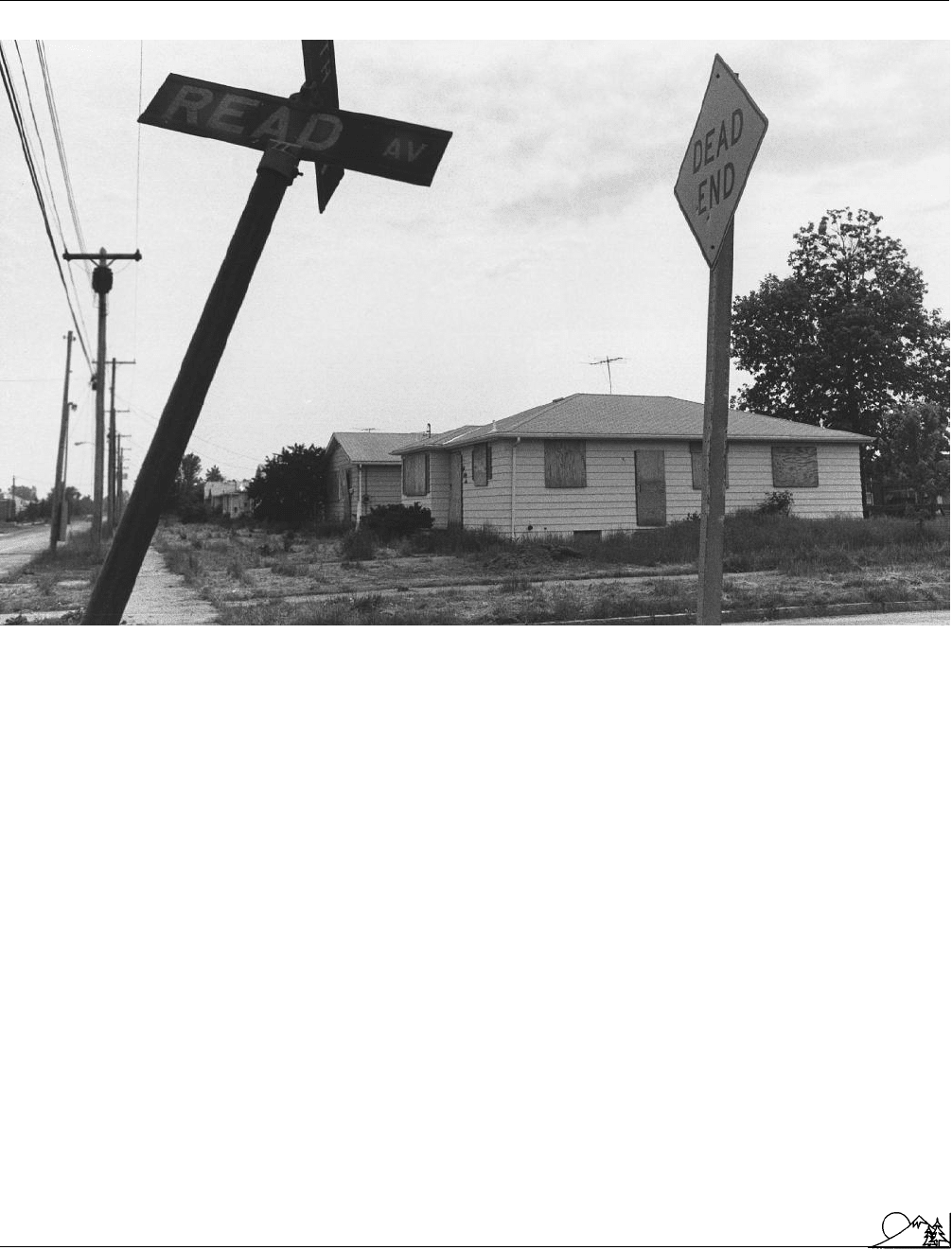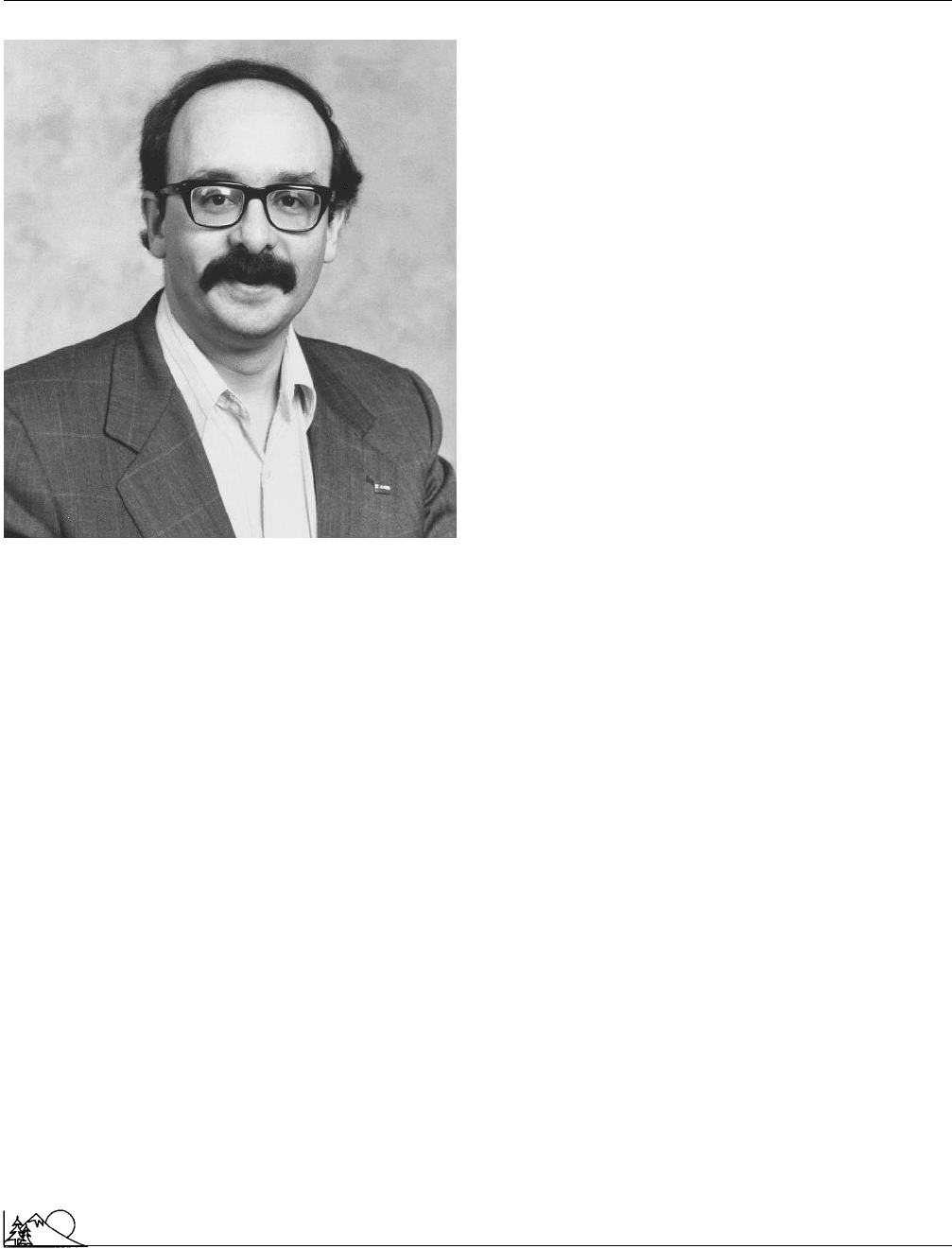Environmental Encyclopedia
Подождите немного. Документ загружается.


Environmental Encyclopedia 3
Los Angeles Basin
London Dumping Convention
see
Convention on the Prevention of
Marine Pollution by Dumping of Waste and
Other Matter (1972)
Barry Holstun Lopez (1945 – )
American environmental writer
Barry Lopez has often called his own nonfiction writing
natural history, and he is often categorized as a
nature
writer. This partially describes his work, but limiting him
to that category is misleading, partly because his work tran-
scends the kinds of subjects implicit in that classification.
He could as well, for example, be called a travel writer,
though that label also does not completely describe his work.
He has in addition published a number of unusual works of
fiction, and even has one children’s book (on Crow and
Weasel) to his credit.
Barry Lopez was born in Port Chester, New York,
but he spent several early childhood years in rural southern
California and, at the age of 10, returned to the East to
grow up in New York City. He earned a BA degree from
the University of Notre Dame, followed by an MAT from
the University of Oregon in 1968. His initial goal was to
teach, but in the late 1960s he set out to become a profes-
sional writer and since 1970 has earned his living writing
(as well as by lecturing and giving readings).
Lopez’s nonfiction writing transcends the category of
natural history because his real topic, as Rueckert suggests, is
the search for human relationships with nature, relationships
that are “dignified and honorable.” Natural history as a cate-
gory of literature implies a focus on primeval nature undis-
turbed by human activity, or at least on nature as it exists
in its own right rather than as humans relate to it. He is a
practitioner of what some have called “the new naturalism—
a search for the human as mirrored in nature.” Lopez’s focus
then is
human ecology
, the interactions of human beings
with the world around them, especially the natural world.
Even his most “natural” book of natural history, Of Wolves
and Men, is not just about the natural history of
wolves
but about how that species’ existence or “being” in the wild
is affected by human perceptions and actions, and it is as
well about the image of the wolf in human minds.
His fiction works can be called unusual, partly because
they are often presented as brief notes or sketches, and partly
because they are frequently blended into and combined with
legends, factual observations of nature, and personal medita-
tions. Everything Lopez writes, however, is in the form of
a story, whether fiction, natural history, folklore, or travel
writing. His story-telling makes all of his writing enjoyable
to read, easy to access and ingest, and often memorable.
847
Lopez as a story teller, occupies the spaces between
truth-teller and mystic, between natural scientist and folklor-
ist. He has written of wolves and humans, and then of
people with blue skins who could not speak and, apparently,
subsisted only on clean air. He writes of the land in reality
and the land in our imaginations, frequently in the same
text. His writings on natural history provide the reader with
great detail about the places in the world he describes, but
his fiction can force the shock of recognition of places in
the mind. In 1998, Lopez was a National Magazine Award
in Fiction finalist for The Letters of Heaven and in 1999 he
received the Lannan residency fellowship.
Barry Lopez is in part a naturalist, in the best sense
of that word. He is also something of an anthropologist.
He is a student of folklore and mythology. He travels widely,
but he studies his own home place and local
environment
intently. And, of course, he is a writer.
[Gerald L. Young Ph.D.]
R
ESOURCES
B
OOKS
Lopez, Barry. About this Life: Journeys on the Threshold of Memory. Ran-
dom, 1998.
———. Arctic Dreams: Imagination and Desire in a Northern Landscape.
New York: Scribner, 1986.
———. Crossing Open Ground. New York: Scribner, 1988.
———. Desert Notes; Reflections in the Eye of a Raven. Kansas City: Sheed,
Andrews & McMeel.
———. Lessons from the Wolverine. Illustrated by Tom Pohrt. University
of Georgia Press, 1997.
———. Light Action in the Caribbean. Knopf, 2000.
Rueckert, W. H. “Barry Lopez and the Search for a Dignified and Honor-
able Relationship With Nature.” In Earthly Words: Essays on Contemporary
American Nature and Environmental Writers. Ed. J. Cooley. Ann Arbor:
University of Michigan Press, 1994.
P
ERIODICALS
Paul, S. “Barry Lopez.” Hewing to Experience: Essays and Reviews on Recent
American Poetry and Poetics, Nature and Culture. Iowa City: University of
Iowa Press, 1989.
Los Angeles Basin
The second most populous city in the United States, Los
Angeles has perhaps the most fascinating
environmental
history
of any urban area in the country. The Los Angeles
Basin, into which more than 80 communities of Los Angeles
County are crowded, is a trough-shaped region bounded on
three sides by the Santa Monica, Santa Susana, San Gabriel,
San Bernadino, and Santa Ana Mountains. On its fourth
side, the county looks out over the Pacific Ocean.
The earliest settlers arrived in the Basin in 1769 when
Spaniard Gaspar de Portola
´
and his expedition set up camp

Environmental Encyclopedia 3
Los Angeles Basin
along what is now known as the Los Angeles River. The
site was eventually given the name El Pueblo de la Reyna
de Los Angeles (the Town of the Queen of the Angels).
For the first century of its history, Los Angeles grew
very slowly. Its population in 1835 was only 1,250. By the
end of the century, however, the first signs of a new trend
appeared. In response to the promises of sunshine, warm
weather, and “easy living,” immigrants from the East Coast
began to arrive in the Basin. Its population more than quad-
rupled between 1880 and 1890, from 11,183 to 50,395.
The rush was on, and it has scarcely abated today.
The metropolitan population grew from 102,000 in 1900
to 1,238,000 in 1930 to 3,997,000 in 1950 to 9,838,861
in 2000.
The
pollution
facing Los Angeles today results from
a complex mix of natural factors and intense
population
growth
. The first reports of Los Angeles’s famous
photo-
chemical smog
go back to 1542. The “many smokes” de-
scribed by Juan Cabrillo in that year were not the same as
today’s
smog
, but they occurred because of geographic and
climatic conditions that are responsible for modern environ-
mental problems.
The Los Angeles Basin has one of the highest proba-
bilities of experiencing thermal inversions of any area in the
United States. An inversion is an atmospheric condition in
which a layer of cold air becomes trapped beneath a layer
of warm air. That situation is just the reverse of the most
normal atmospheric condition in which a warm layer near
the ground is covered by a cooler layer above it. The warm
air has a tendency to rise, and the cool air has a tendency
to sink. As a result, natural mixing occurs. In contrast, when
a thermal inversion occurs, the denser cool air remains near
the ground while the less dense air above it tends to stay
there.
Smoke
and other pollutants released into a thermal
inversion are unable to rise upward and tend to be trapped
in the cool lower layer. Furthermore, horizontal movements
of air, which might clear out pollution in other areas, are
blocked by the mountains surrounding LA county. The lin-
gering
haze
of the “many smokes” described by Cabrillo
could have been nothing more than the smoke from camp-
fires trapped by inversions that must have existed even in
1542.
As population and industrial growth occurred in Los
Angeles during the second half of the twentieth century,
the amount of pollutants trapped in thermal inversions also
grew. By the 1960s, Los Angeles had become a classic exam-
ple of how modern cities were being choked by their own
wastes.
The geographic location of the Los Angeles Basin
contributes another factor to Los Angeles’s special environ-
mental problems. Sunlight warms the Basin for most of the
848
year and attracts visitors and new residents.
Solar energy
fuels reactions between components of Los Angeles’s pol-
luted air, producing
chemicals
even more toxic than those
from which they came. The complex mixture of noxious
compounds produced in Los Angeles has been given the
name smog, reflecting the combination of human (smoke)
and natural factors (fog) that make it possible. Smog, also
called ground level
ozone
, can cause a myriad of health
problems including breathing difficulties, coughing, chest
pains, and congestion. It may also exacerbate
asthma
, heart
disease, and
emphysema
.
As Los Angeles grew in area and population, condi-
tions which guaranteed a continuation of smog increased.
The city and surrounding environs eventually grew to cover
400 square miles (1,036 square kilometers), a widespread
community held together by freeways and cars. A major oil
company bought the city’s public transit system, then closed
it down, ensuring the wide use of
automobile transporta-
tion
. Thus, gases produced by the
combustion
of
gasoline
added to the city’s increasing pollution levels.
Los Angeles and the State of California have been
battling
air pollution
for over 20 years. California now has
some of the strictest
emission standards
of any state in
the nation, and LA has begun to develop
mass transit
systems once again. For an area that has long depended on
the automobile, however, the transition to public transporta-
tion has not been an easy one. But some measurable progress
has been made in controlling ground level ozone. In 1976,
smog was detectable at levels above the state standard accept-
able average of 0.09 ppm a staggering 237 days out of the
year. By 2001, the number had dropped to 121 days. Still,
much work remains to be done; in 2000, 2001, and 2002 Los
Angeles topped the American Lung Association’s annual list
of most ozone polluted cities and counties.
Another of Los Angeles’s population-induced prob-
lems is its enormous demand for water. As early as 1900, it
was apparent that the Basin’s meager
water resources
would be inadequate to meet the needs of the growing urban
area. The city turned its sights on the Owens Valley, 200
mi (322 km) to the northeast in the Sierra Nevada. After a
lengthy dispute, the city won the right to tap the water
resources of this distant valley. A 200-mile water diversion
public works project, the Los Angeles Aqueduct, was com-
pleted in 1913.
This development did not satisfy the area’s growing
need for water, however, and in the 1930s, a second canal
was built. This canal, the
Colorado River
Aqueduct, carries
water from the Colorado River to Los Angeles over a dis-
tance of 444 mi (714 km). Even this proved to be inadequate,
however, and the search for additional water sources has
gone on almost without stop. In fact, one of the great on-
going debates in California is between legislators from

Environmental Encyclopedia 3
Love Canal
Northern California, where the state’s major water resources
are located, and their counterparts from Southern California,
where the majority of the state’s people live. Since the latter
contingent is larger in number, it has won many of the
battles so far over distribution of the state’s water resources.
Of course, Los Angeles has also experienced many of
the same problems as urban areas in other parts of the world,
regardless of its special geographical character. For example,
the Basin was at one time a lush agricultural area, with some
of the best
soil
and growing conditions found anywhere.
From 1910 to 1950, Los Angeles County was the wealthiest
agricultural region in the nation. But as urbanization pro-
gressed, more and more farmland was sacrificed for commer-
cial and residential development. During the 1950s, an aver-
age of 3,000 acres (1,215 hectares) of farmland per day
was taken out of production and converted to residential,
commercial, industrial, or transportation use.
One of the mixed blessings faced by residents of the
Los Angeles Basin is the existence of large oil reserves in
the area. On the one hand, the oil and
natural gas
contained
in these reserves is a valuable natural resource. On the other
hand, the presence of working oil
wells
in the middle of a
modern metropolitan area creates certain problems. One is
aesthetic, as busy pumps in the midst of barren or scraggly
land contrasts with sleek new glass and steel buildings.
Another petroleum-related difficulty is that of land
subsidence
. As oil and gas are removed from underground,
land above it begins to sink. This phenomenon was first
observed as early as 1937. Over the next two decades, subsi-
dence had reached 16 ft (5 m) at the center of the Wilming-
ton oil fields. Horizontal shifting of up to 9 ft (2.74 m) was
also recorded.
Estimates of subsidence of up to 45 ft (14 m) spurred
the county to begin remedial measures in the 1950s. These
measures included the construction of levees to prevent sea-
water from flowing into the subsided area and the repressur-
izing of oil zones with water injection. These measures have
been largely successful, at least to the present time, in halting
the subsidence of the oil field.
Los Angeles’ annual ritual of pumping and storing
water into underground aquifers in anticipation of the long,
dry summer season has also been responsible for elevation
shifts in the region. Researchers with the United States
Geological Survey
(USGS) observed that the ground sur-
face of a 20 by 40 km area of Los Angeles rises and falls
approximately 10–11 centimeters annually in conjunction
with the water storage activities.
As if population growth itself were not enough, the
Basin poses its own set of natural challenges to the commu-
nity. For example, the area has a typical Mediterranean
climate
with long hot summers, and short winters with little
rain. Summers are also the occasion of Santa Ana winds,
849
severe windstorms in which hot air sweeps down out of the
mountains and across the Basin. Urban and forest fires that
originate during a Santa Ana wind not uncommonly go out
of control causing enormous devastation to both human
communities and the natural
environment
.
The Los Angeles Basin also sits within a short distance
of one of the most famous fault systems in the world, the
San Andreas Fault. Other minor faults spread out around
Los Angeles on every side. Earthquakes are common in
the Basin, and the most powerful
earthquake
in Southern
California history struck Los Angeles in 1857 (8.25 magni-
tude). Sixty miles (97 kilometers) from the quake’s epicenter,
the tiny community of Los Angeles lost the military base
at Fort Tejon although only two lives were lost in the disaster.
Like San Franciscans, residents of the Los Angeles Basin
live not wondering if another earthquake will occur, but
only when “The Big One” will hit. See also Air quality;
Atmospheric inversion; Environmental Protection Agency
(EPA); Mass transit; Oil drilling
[David E. Newton and Paula Anne Ford-Martin]
R
ESOURCES
B
OOKS
Davis, Mike. Ecology of Fear: Los Angeles and the Imagination of Disaster.
New York: Vintage Books, 1999.
Gumprecht, Blake. The Los Angeles River: Its Life, Death, and Possible
Rebirth Baltimore: John Hopkins University Press, 2001.
P
ERIODICALS
Hecht, Jeff. “Finding Fault” New Scientist 171 (August 2001): 8.
O
THER
American Lung Association. State of the Air 2002 Report. [cited July 9,
2002]. <http://www.stateoftheair.org>.
South Coast Air Quality Management District. Smog Levels. [cited July 9,
2002]. <http://ozone.aqmd.gov/smog>.
United States Geological Survey (USGS). Earthquake Hazards Program:
Northern California. [cited July 9, 2002]. <http://quake.usgs.gov>.
Love Canal
Probably the most infamous of the nation’s
hazardous
waste
sites, the Love Canal neighborhood of Niagara Falls,
New York, was largely evacuated of its residents in 1980
after testing revealed high levels of toxic
chemicals
and
genetic damage.
Between 1942 and 1953, the Olin Corporation and
the Hooker Chemical Corporation buried over 20,000 tons
of deadly chemical waste in the canal, much of which is
known to be capable of causing
cancer
,
birth defects
, mis-
carriages, and other health disorders. In 1953, Hooker
deeded the land to the local board of education but did not
clearly warn of the deadly nature of the chemicals buried

Environmental Encyclopedia 3
Love Canal
Weeds grow around boarded up homes in Love Canal, New York in 1980. (Corbis-Bettmann. Reproduced by permission.)
there, even when homes and playgrounds were built in
the area.
The seriousness of the situation became apparent in
1976, when years of unusually heavy rains raised the
water
table
and flooded basements. As a result, houses began to
reek of chemicals, and children and pets experienced chemi-
cal burns on their feet. Plants, trees, gardens, and even some
pets died.
Soon neighborhood residents began to experience an
extraordinarily high number of illnesses, including cancer,
miscarriages, and deformities in infants. Alarmed by the
situation, and frustrated by inaction on the part of local,
state, and federal governments, a 27-year-old housewife
named Lois Gibbs began to organize her neighbors. In 1978
they formed the Love Canal Homeowners Association and
began a two-year fight to have the government relocate them
into another area.
In August 1978 the New York State Health Commis-
sioner recommended that pregnant women and young chil-
dren be evacuated from the area, and subsequent studies
documented the extraordinarily high rate of birth defects,
miscarriages, genetic damage and other health affects. In
850
1979, for example, of 17 pregnant women in the neighbor-
hood, only two gave birth to normal children. Four had
miscarriages, two suffered stillbirths, and nine had babies
with defects.
Eventually, the state of New York declared the area “a
grave and imminent peril” to human health. Several hundred
families were moved out of the area, and the others were
advised to leave. The school was closed and barbed wire
placed around it. In October 1980 President Jimmy Carter
declared Love Canal a national disaster area.
In the end, some 60 families decided to remain in
their homes, rejecting the government’s offer to buy their
properties. The cost for the cleanup of the area has been
estimated at $250 million. Ironically, twelve years after the
neighborhood was abandoned, the state of New York ap-
proved plans to allow families to move back to the area, and
homes were allowed to be sold.
Love Canal is not the only hazardous waste site in the
country that has become a threat to humans--only the best
known. Indeed, the United States
Environmental Protec-
tion Agency
has estimated that up to 2,000 hazardous waste
disposal sites in the United States may pose “significant risks

Environmental Encyclopedia 3
Sir James Ephraim Lovelock
to human health or the environment,” and has called the
toxic waste problem “one of the most serious problems the
nation has ever faced.” See also Contaminated soil; Hazard-
ous waste site remediation; Hazardous waste siting; Leach-
ing; Storage and transport of hazardous material; Stringfel-
low Acid Pits; Toxic substance
[Lewis G. Regenstein]
R
ESOURCES
B
OOKS
Gibbs, Lois. Love Canal: My Story. Albany: State University of New York
Press, 1982.
Regenstein, L. G. How to Survive in America the Poisoned. Washington,
DC: Acropolis Books, 1982.
P
ERIODICALS
Brown, M. H. “Love Canal Revisited.” Amicus Journal 10 (Summer 1988):
37–44.
Kadlecek, M. “Love Canal—10 Years Later.” Conservationist 43 (Novem-
ber-December 1988): 40–43.
———. “A Toxic Ghost Town: Ten Years Later, Scientists Are Still
Assessing the Damage From Love Canal.” The Atlantic 263 (July 1989):
23–26.
Sir James Ephraim Lovelock (1919 – )
English chemist
Sir James Lovelock is the framer of the
Gaia hypothesis
and developer of, among many other devices, the electron
capture gas chromatographic detector. The highly selective
nature and great sensitivity of this detector made possible
not only the identification of
chlorofluorocarbons
in the
atmosphere
, but led to the measurement of many pesti-
cides, thus providing the raw data that underlie Rachel Car-
son’s Silent Spring.
Sir James Lovelock was born in Letchworth Garden
City, earned his degree in chemistry from Manchester Uni-
versity, and took a Ph.D. in medicine from the London
School of Hygiene and Tropical Medicine. His early studies
in medical topics included work at Harvard University Medi-
cal School and Yale University. He spent three years as
a professor of chemistry at Baylor University College of
Medicine in Houston, Texas. It was from that position that
his work with the Jet Propulsion Laboratory for NASA
began.
The Gaia hypothesis, Sir James Lovelock’s most sig-
nificant contribution to date, grew out of the work of Sir
James Lovelock and his colleagues at the lab. While at-
tempting to design experiments for life detection on Mars,
Sir James Lovelock, Dian Hitchcock, and later Lynn Mar-
gulis, posed the question, “If I were a Martian, how would
851
Sir James E. Lovelock at his home in Cornwall
with thedevice he invented to measure chloro-
fluorocarbons in the atmosphere. (Photograph by
Anthony Howarth. Photo Researchers Inc. Reproduced by
permission.)
I go about detecting life on Earth?” Looking in this way,
the team soon realized that our atmosphere is a clear sign
of life and it is totally impossible as a product of strictly
chemical equilibria. One consequence of viewing life on this
or another world as a single homeostatic organism is that
energy will be found concentrated in certain locations rather
than spread evenly, frequently, or even predominantly, as
chemical energy. Thus, against all
probability
, the earth
has an atmosphere containing about 21% free oxygen and
has had about this much for millions of years. Sir James
Lovelock bestowed on this superorganism comprising the
whole of the
biosphere
the name “Gaia,” one spelling of
the name of the Greek earth-goddess, at the suggestion of
a neighbor, William Golding, author of Lord of the Flies.
Sir James Lovelock’s hypothesis was initially attacked
as requiring the whole of life on earth to have purpose,
and hence in some sense, common intelligence. Sir James
Lovelock then developed a computer model called
“Daisyworld” in which the presence of black and white dai-
sies controlled the global temperature of the planet to a
nearly constant value despite a major increase in the heat
output of its sun. The concept that the biosphere keeps
the
environment
constant has been attacked as sanctioning

Environmental Encyclopedia 3
Amory Bloch Lovins
environmental degradation
, and accusers took a cynical
view of Sir James Lovelock’s service to the British
petro-
chemical
industry. However, the hypothesis has served the
environmental community well in suggesting many ideas
for further studies, virtually all of which have given results
predicted by the hypothesis.
Since 1964, Sir James Lovelock has operated a private
consulting practice, first out of his home in Bowerchalke,
near Salisbury, England, and later from a home near Launc-
eston, Cornwall. He has authored over 200 scientific papers,
covering research that ranged from techniques for freezing
and successfully reviving hamsters to global systems science,
which he has proposed to call geophysiology. Sir James
Lovelock has been honored by his peers worldwide with
numerous awards and honorary degrees, including Fellow
of the Royal Society. He was also named a Commander of
the British Empire by Queen Elizabeth in 1990.
[James P. Lodge Jr.]
R
ESOURCES
B
OOKS
Joseph, L. E. Gaia: The Growth of an Idea. New York: St. Martin’s
Press, 1990.
Lovelock, J. The Ages of Gaia, A Biography of Our Living Earth. New York:
Norton, 1988.
———. Gaia, a New Look at Life on Earth. Oxford: Oxford University
Press, 1979.
———, and M. Allaby. The Greening of Mars. New York: St. Martin’s
Press, 1984.
Amory Bloch Lovins (1947 – )
American physicist and energy conservationist
Amory Lovins is a physicist specializing in environmentally
safe and sustainable energy sources. Born in 1947 in Wash-
ington, D.C., Lovins attended Harvard and Oxford universi-
ties. He has had a distinguished career as an educator and
scientist. After resigning his academic post at Oxford in
1971, Lovins became the British representative of
Friends
of the Earth
. He has been Regents’ Lecturer at the University
of California at Berkeley and has served as a consultant to the
United Nations and other international and environmental
organizations. Lovins is a leading critic of hard energy paths
and an outspoken proponent of soft alternatives.
According to Lovins, an energy path is “hard” if the
route from source to use is complex and circuitous requires
extensive, expensive, and highly complex technological
means and centralized power to produce, transmit, and store
the energy produces toxic wastes or other unwanted side
effects has hazardous social uses or implications and tends
over time to harden even more, as other options are fore-
852
closed or precluded as the populace becomes ever more de-
pendent on energy from a particular source. A hard energy
path can be seen in the case of fossil fuel energy. Once
readily abundant and cheap,
petroleum
fueled the internal
combustion
engines and other machines on which humans
have come to depend, but as that energy source becomes
scarcer, oil companies must go farther afield to find it, poten-
tially causing more environmental damage. As oil supplies
run low and become more expensive, the temptation is to
sustain the level of energy use by turning to another, and
even harder, energy path—nuclear energy.
With its complex technology, its hazards, its long-
lived and highly toxic wastes, its myriad military uses, and
the possibility of its falling into the hands of dictators or
terrorists,
nuclear power
is perhaps the hardest energy path.
No less important are the social and political implications
of this hard path: radioactive wastes will have to be stored
somewhere nuclear
power plants
and
plutonium
transport
routes must be guarded we must make trade-offs between
the ease, convenience, and affluence of people presently liv-
ing and the health and well-being of
future generations
and so on. A hard energy path is also one that, once taken,
forecloses other options because, among other considera-
tions, the initial investment and costs of entry are so high
as to render the decision, once made, nearly irreversible. The
longer term economic and social costs of taking the hard
path, Lovins argues, are astronomically high and incalcu-
lable.
Soft energy paths, by contrast, are shorter, more direct,
less complex, cheaper (at least over the long run), are inex-
haustible and renewable, have few if any unwanted side-
effects, have minimal military uses, and are compatible with
decentralized local forms of community control and deci-
sion-making. The old windmill on the family farm offers
an early example of such a soft energy source newer versions
of the windmill, adapted to the generation of electricity,
supply a more modern example. Other soft technologies
include
solar energy
,
biomass
furnaces burning peat, dung
or wood chips, and
methane
from the rotting of vegetable
matter, manure, and other cheap, plentiful, and readily avail-
able organic material.
Much of Lovins’s work has dealt with the technical
and economic aspects, as well as the very different social
impacts and implications, of these two competing energy
paths. A resource consultant agency, The
Rocky Mountain
Institute
, was founded by Lovins and his wife, Hunter in
1982. In 1989, Lovins and his wife won the Onassis Founda-
tion’s first Delphi Prize for their “essential contribution to-
wards finding alternative solutions to energy problems.”
[Terence Ball]

Environmental Encyclopedia 3
Low-head hydropower
Amory Lovins. (Reproduced by permission of the Rocky
Mountain Institute.)
R
ESOURCES
B
OOKS
Nash, H., ed. The Energy Controversy: Amory B. Lovins and His Critics.
San Francisco: Friends of the Earth, 1979.
Lovins, A. B. Soft Energy Paths. San Francisco: Friends of the Earth, 1977.
———, and L. H. Lovins. Energy Unbound: Your Invitation to Energy
Abundance. San Francisco: Sierra Club Books, 1986.
P
ERIODICALS
Louma, J. R. “Generate ’Nega-Watts’ Says Fossil Fuel Foe.” New York
Times (April 2, 1993): B5, B8.
Lowest Achievable Emission Rate
Governments have explored a number of mechanisms for
reducing the amount of pollutants released to the air by
factories,
power plants
, and other stationary sources. One
mechanism is to require that a new or modified installation
releases no more pollutants than determined by some law
or regulation determining the lowest level of pollutants that
can be maintained by existing technological means. These
limits are known as the Lowest Achievable Emission Rate
(LAER). The
Clean Air Act
of 1970 required, for example,
that any new source in an area where minimum
air pollution
standards were not being met had to conform to the LAER
853
standard. See also Air quality; Best Available Control Tech-
nology (BAT); Emission standards
Low-head hydropower
The term hydropower often suggests giant
dams
capable
of transmitting tens of thousands of cubic feet of water per
minute. Such dams are responsible for only about six percent
of all the electricity produced in the United States today.
Hydropower facilities do not have to be massive build-
ings. At one time in the United States--and still, in many
places around the world--electrical power is generated at
low-head facilities, dams where the vertical drop through
which water passes is a relatively short distance and/or where
water flow is relatively modest. Indeed, the first commercial
hydroelectric facility in the world consisted of a waterwheel
on the Fox River in Appleton, Wisconsin. The facility,
opened in 1882, generated enough electricity to operate
lighting systems at two paper mills and one private residence.
Electrical demand grew rapidly in the United States
during the early twentieth century, and hydropower supplied
much of that demand. By the 1930s, nearly 40 percent of the
electricity used in this country was produced by hydroelectric
facilities. In some Northeastern states, hydropower ac-
counted for 55-85 percent of the electricity produced.
A number of social, economic, political, and technical
changes soon began to alter that pattern. Perhaps most im-
portant was the vastly increased efficiency of
power plants
operated by
fossil fuels
. The fraction of electrical power
from such plants rose to more than 80 percent by the 1970s.
In addition, the United States began to move from a
decentralized energy system in which many local energy
companies met the needs of local communities, to large,
centralized utilities that served many counties or states. In
the 1920s, more than 6,500 electric power companies existed
in the nation. As the government recognized power compa-
nies as monopolies, that number began to drop rapidly.
Companies that owned a handful of low-head dams on one
or more rivers could no longer compete with their giant
cousins that operated huge plants powered by oil,
natural
gas
,or
coal
.
As a result, hundreds of small hydroelectric plants
around the nation were closed down. According to one study,
over 770 low-head hydroelectric plants were abandoned be-
tween 1940 and 1980. In some states, the loss of low-head
generating capacity was especially striking. Between 1950
and 1973, Consumers Power Company, one of Michigan’s
two
electric utilities
, sold off 44 hydroelectric plants.
Some experts believe that low-head hydropower
should receive more attention today. Social and technical
factors still prevent low-head power from seriously compet-

Environmental Encyclopedia 3
Low-level radioactive waste
ing with other forms of energy on a national scale. But it
may meet the needs of local communities in special circum-
stances. For example, a project has been undertaken to reha-
bilitate four low-head dams on the Boardman River in north-
western Michigan. The new facility is expected to increase
the electrical energy available to nearby Traverse City and
adjoining areas by about 20 percent.
Low-head hydropower appears to have a more promis-
ing future in less-developed parts of the world. For example,
China has more than 76,000 low-head dams that generate
a total of 9,500 megawatts of power. An estimated 50 percent
of rural townships depend on such plants to meet their
electrical needs. Low-head hydropower is also of increasing
importance in nations with fossil-fueled plants and growing
electricity needs. Among the fastest growing of these are
Peru, India, the Philippines, Costa Rica, Thailand, and Gua-
temala. See also Alternative energy sources; Electric utilities;
Wave power
[David E. Newton]
R
ESOURCES
B
OOKS
Lapedes, D. N., ed. McGraw-Hill Encyclopedia of Energy. New York:
McGraw-Hill, 1976.
P
ERIODICALS
Kakela, P., G, Chilson, and W. Patric. “Low-Head Hydropower for Local
Use.” Environment (January-February 1984): 31–38.
Low-inut agriculture
see
Sustainable agriculture
Low-level radioactive waste
Low-level
radioactive waste
consists of materials used in
a variety of medical, industrial, commercial, and research
applications. They tend to release a low level of radiation
that dissipates in a relatively short period of time. Although
care must be taken in handling such materials, they pose
little health or environmental risk. Among the most common
low level radioactive materials are rags, papers, protective
clothing, and
filters
. Such materials are often stored tempo-
rarily in sealed containers at their use site. They are then
disposed of by burial at one of three federal sites: Barnwell,
South Carolina, Beatty, Nevada, or Hanford, Washington.
See also Hanford Nuclear Reservation; High-level radioactive
waste; Radioactive waste; Radioactivity
LUST
see
Leaking underground storage tank
854
Sir Charles Lyell (1797 – 1875)
Scottish geologist
Lyell was born in Kinnordy, Scotland, the son of well-to-
do parents. When Lyell was less than a year old, his father
moved his family to the south of England where he leased
a house near the New Forest in Hampshire. Lyell spent his
boyhood there, surrounded by his father’s collection of rare
plants. At the age of seven, Lyell became ill with pleurisy
and while recovering began to collect and study insects. As
a young man he entered Oxford to study law, but he also
became interested in mineralogy after attending lectures by
the noted geologist William Buckland. Buckland advocated
the theories of Abraham Gottlob Werner, a neptunist who
postulated that a vast ocean once covered the earth and that
the various rocks resulted from chemical and mechanical
deposition underwater, over a long period of time. This
outlook was more in keeping with the Biblical story of Gene-
sis than that of the vulcanists or plutonists who suscribed
to the idea that volcanism, along with
erosion
and deposi-
tion, were the major forces sculpting the Earth. While on
holidays with his family, Lyell made the first of many obser-
vations in hopes of confirming the views of Buckland and
Werner. However, he continued to study law and was even-
tually called to the bar in 1822. Lyell practiced law until
1827 while still devoting time to geology.
Lyell traveled to France and Italy where he collected
extensive data which caused him to reject the neptunist
philosophy. He instead drew the conclusion that volcanic
activity and erosion by wind and weather were primarily
responsible for the different strata rather than the deposition
of sediments from a “world ocean.” He also rejected the
catastrophism of Georges Cuvier, who believed that global
catastrophes, such as the biblical Great Flood, periodically
destroyed life on Earth, thus accounting for the different
fossils found in each rock layer. Lyell believed change was
a gradual process that occurred over a long period of time
at a constant rate. This theory, known as uniformitarianism,
had been postulated 50 years earlier by Scottish geologist
James Hutton. It was Lyell, though, who popularized unifor-
mitarianism in his work The Principles of Geology, which is
now considered a classic text in this field. By 1850 his views
and those of Hutton had become the standard among geolo-
gists. However, unlike many of his colleagues, Lyell adhered
so strongly to uniformitarianism that he rejected the possibil-
ity of even limited catastrophe. Today most scientists accept
that catastrophes such as meteor impacts played an impor-
tant, albeit supplemental, role in the earth’s
evolution
.
In addition to his championing of uniformitarianism,
Lyell named several divisions of geologic time such as the
Eocene, Miocene, and Pliocene Epochs. He also estimated
the age of some of the oldest fossil-bearing rocks known at

Environmental Encyclopedia 3
Lysimeter
that time, assigning them the then startling figure of 240
million years. Even though Lyell came closer than his con-
temporaries to guessing the correct age, it is still less than
half the currently accepted figure used by geologists today.
While working on The Principles of Geology, Lyell formed a
close friendship with Charles Darwin who had outlined his
evolutionary theory in The Origin of Species. Both scientists
quickly accepted the work of the other (Lyell was one of
two scientists who presented Darwin’s work to the influential
Linnaean Society). Lyell even extended evolutionary theory
to include humans at a time when Darwin was unwilling to
do so. In his The Antiquity of Man (1863), Lyell argued that
humans were much more ancient than creationists (those
who interpreted Book of Genesis literally) and catastrophists
believed, basing his ideas on archaeological artifacts such as
ancient ax heads. Lyell was knighted for his work in 1848
and created a baronet in 1864. He also served as president
of the Geological Society and set up the Lyell Medal and
the Lyell Fund. He died in 1875 while working on the
twelfth edition of his Principles of Geology.
R
ESOURCES
B
OOKS
Adams, Alexander B. “Reading the Earth’s Story: Charles Lyell—1979–
1875.” In Eternal Quest: The Story of the Great Naturalists. NY: G. P.
Putnam’s Sons, 1969.
855
Wilson, Leonard G. Charles Lyell—The Years to 1841: The Revolution in
Geology. New Haven, CN: Yale University Press, 1972.
P
ERIODICALS
Camardi, Giovanni. “Charles Lyell and the Uniformity Principle.” Biology
and Philosophy 14, no. 4 (October 1999): 537–560.
Kennedy, Barbara A. “Charles Lyell and ’Modern Changes of the Earth’:
the Milledgeville Gully.” Geomorphology 40 (2001): 91–98.
Lysimeter
A device for 1) measuring
percolation
and
leaching
losses
from a column of
soil
under controlled conditions, or 2) for
measuring gains (precipitation,
irrigation
, and condensa-
tion) and losses (
evapotranspiration
) by a column of soil.
Many kinds of lysimeters exist: weighing lysimeters record
the weight changes of a block of soil; non-weighing lysime-
ters enclose a block of soil so that losses or gains in the soil
must occur through the surface suction lysimeters are devises
for removing water and dissolved
chemicals
from locations
within the soil.
Lythrum salicaria
see
Purple loosestrife
This Page Intentionally Left Blank
